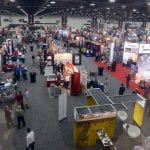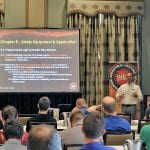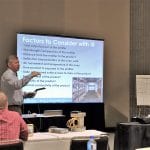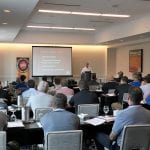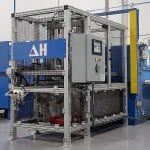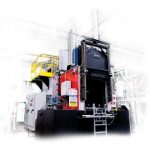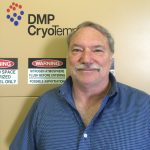Tailoring advanced ceramics to meet niche properties
Ceramics are traditionally described as inorganic, nonmetallic solids that are prepared from powdered raw materials and fabricated into products through the application of heat....
Determining heat-treat operator training
With the fast pace of change in the heat-treat industry, it is understandable that more automation is in demand. This automation inevitably improves repeatability...
Anatomy of a Heat-Treating System
Ninety-eight 600-pound trays are in continuous process, 13 are in the pre-process queue, nine preheating, 14 in the boost carb, eight in the diffusion...
Control of distortion in heat-treated aluminum
In this column, we will discuss controlling the distortion of aluminum heat-treated components.
The heat treatment of aluminum (solution heat treatment, quenching and aging) are...
Use of molten salts for martempering of steel
In July’s column, I talked about molten salts and the different types. In this short column, we discuss the benefits of using molten salts...
Understanding gas composition
Evaluating furnace atmospheres for proper gas composition is the key to desired performance results
Q&A with Matthias Pascher
What is your role at Buehler?
I am the product manager for our hardness testing equipment within Buehler.
Buehler is a global supplier of apparatus for...
Q&A with Tom Ott
Most people don’t associate hardness testing with heat treatment, but it’s very relevant. You say there are a number of products that are really...
Q&A with Andrew Bassett
How did ATP get started?
During the early 1990s, the National Aerospace and Defense Contractors Accreditation Program (Nadcap) began embracing all special processes, and we...
Developing a superalloy with superior heat resistance
Demand for superior machinery that can operate effectively under extreme conditions is driving the development of newer alloys. One significant example is the preparation...
Q&A with Joe Stambaugh
Pease tell us a little about your background and company.
My education was in electromechanical technologies. I have spent my 40-year career working in the...
The art of heat treat: The framework
I was once taught that heat treat is an art as much as it is a science in achieving the results required for the...
Q&A with Guido Locatelli
Tell us about your company.
The company was established in 1984 near Milan, Italy, in the city of Caravaggio, and since its inception the headquarters...
Q&A with Jim Litzinger
Your company, Orton, offers TempTabs, some pretty ingenious technology for monitoring temperature throughout a furnace. How did the idea come about?
Our founder, Edward Orton...
Quality review: Heat-treat related certifications
As heat treaters, we must admit that, at the end of the day, what we feel we are paying for is a certification that...
Q&A with Richard Slattery
Vice President, Engineering with Capstan Atlantic
Furnace atmospheres and temperature
Getting the Right Protective and Carburizing Atmosphere
The makeup of a furnace’s atmosphere in the heat treating process varies based upon the application. For carburizing,...
Q&A with Heat Treat 2019 attendees
HEAT TREAT 2019, is scheduled to hit Detroit, Michigan, October 15–17. The show will bring thousands of industry experts and insiders to the motor...
IHEA Fall Seminar series back in Cleveland
The Industrial Heating Equipment Association (IHEA) heads to Cleveland, Ohio, for its 2019 Fall Seminars and Fall Business Conference. The event will be at...
Q&A with Eric Ford
What does Graphite Metallizing Corporation do for the heat-treat industry?
Graphite Metallizing Corporation makes a product called Graphalloy. It’s basically a graphite/metal alloy, that we...
Infrared technology is hot!
The Industrial Heating Equipment Association’s Infrared Equipment Division (IRED) recently completed revisions to its popular Infrared Process Heating Handbook for Industrial Applications. This fundamental...
Q&A with Adam Jacobson
What’s a typical day like for you at JN Machinery?
We’re a small company, so, it really depends on what’s going on as far as...
IHEA conducts technical seminars in conjunction with Furnaces North America
IHEA conducts technical seminars in conjunction with Furnaces North America
The life of a heat treat process engineer
Editor’s note: Beginning with the March 2020 issue of Thermal Processing, there will be multiple contributors to the Quality Counts column. Conrad Kacsik’s Jason...
Get to know IHEA’s new member: DELTA H TECHNOLOGIES
IHEA’s newest member, DELTA H TECHNOLOGIES, is a growing family business that prides itself on quality and performance. The company was originally established as...
AMS2750 pyrometry revisions tweak a crucial process
AMS2750 pyrometry is a daunting heat-treat special process requirement in the aerospace industry. It’s a literal definition implying measurement of temperature, but it also...
Q&A with Brian Russell
Q: Tell me a little about the history of Dry Coolers, Inc.
We started in 1985 to provide cooling water solutions for heat treating equipment—for...
Intensive Quenching
Heat treating is similar to art in many ways, but not for the reasons you might think. Art, it’s said, is in the eye...
Q&A with Joe Ugalde
Business Marketing Analyst with TE Wire & Cable, LLC
Q&A with Raymond Daniel Noble
What are your duties with Noble Industrial Furnace? What is your typical day?
My duties include, but are not limited to, oversight of design and...
An argument in support of Nadcap
I think it is safe to assume that the majority of Thermal Processing readers have, in some capacity and at some point in their...
A Short Guide on Water Vapor
Water vapor (e.g., excessive retained humidity) is the most commonplace enemy of vacuum furnaces. In fact, it is the No. 1 threat to everyday...
Process Control and Scada
Heat treaters are always looking for methods to improve productivity without compromising quality. One method that many heat treaters have put in place is...
Is there a furnace problem?
That question is much easier to answer if you learn the indicators, alarms, switches
Blistering of aluminum during heat treatment
In this column, we will discuss the blistering of aluminum during heat treatment, and methods to prevent its occurrence.
Introduction
High-temperature oxidation, or blistering, often occurs...
Q&A with Rick Diekman
Owner and President of Controlled Thermal Processing, Inc.
Extending the Hot Zone’s Life Span
One most commonly recommended procedure for making your equipment perform more effectively is to run a cleanup cycle, which removes contaminants from within the...
Q&A with George Barbour
Please tell us a little about Heavy Carbon Co.
The company began in 1995 as an idea for carburizing steel at a cleaner, faster rate...
Q&A with Bob Wells
What are some factors one should consider in cryogenic processing of gears?
First off, what is the size I need? Secondly, how do I want...
Finding leaks in an atmosphere furnace
Visual inspection, routine preventative maintenance of atmosphere furnaces is critical to maintaining safety, efficiency
























